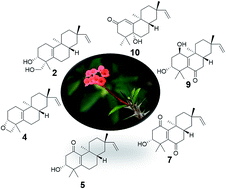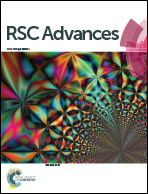ent-Rosane diterpenoids from Euphorbia milii showing an Epstein–Barr virus lytic replication assay†
Abstract
The phytochemical investigation on the acetone extract of Euphorbia milii afforded thirteen new ent-rosane diterpenoids (1–13) through bioassay guided fractionation for evaluating its effect on Epstein–Barr virus (EBV) DNA lytic replication. Structures were determined by comprehensive spectroscopic analyses including 1D & 2D NMR techniques, chemical methods, and experimental and calculated electronic circular dichroism (ECD) data. The absolute configuration of euphominoid A (1) was established by single crystal X-ray diffraction analysis of its p-bromobenzoate derivative 1a. Compounds 1–3, and 10 displayed inhibitory activity with EC50 values ranging from 5.4 to 29.1 μM and selective index (SI) values varied from 4.5 to 9.3. Compound 2 showed the most potent inhibitory activity with an EC50 value of 5.4 μM comparing with the positive control (+)-rutamarin (EC50 = 5.4 μM). This is the first report of ent-rosane-type diterpenoids exhibiting significant inhibition of EBV lytic replication.



 Please wait while we load your content...
Please wait while we load your content...